
Dell Compellent Dynamic Capacity
Maximum utilization with minimal resources
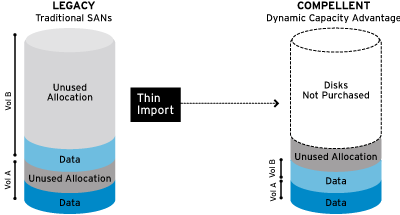
Overview:
Today's virtual server infrastructures demand full visibility into both allocation and how your capacity is actually consumed, as well as the ability to assess how data grows over time. To stay competitive, you need to maximize your storage investment by fully utilizing capacity and gaining the ability to flexibly plan for long-term growth.
Dell Compellent Dynamic Capacity software helps organizations optimize storage utilization by eliminating pre-allocation of capacity. Built into the storage platform, the thin provisioning software allows Dell Compellent storage to consume only the capacity actually used by an application, leaving unused disk space in the storage pool available to all other servers and applications. Administrators can provision any size virtual volume upfront, but consume disk space only when data is written.
Built into every Dell Compellent Storage Center system, thin provisioning delivers efficient storage utilization. Our advanced thin provisioning, called Dynamic Capacity, completely separates storage allocation from utilization, enabling users to allocate any size volume upfront yet only consume physical capacity on write. You can even reclaim capacity that is no longer in use by applications, automatically reduce the space needed for virtual OS volumes and convert traditional volumes on existing storage to thin-provisioned capacity.
Advanced thin provisioning
Dell Compellent Thin Provisioning delivers the highest enterprise storage utilization possible by eliminating pre-allocated but unused capacity. The software, Dynamic Capacity, completely separates allocation from utilization, enabling users to provision any size volume upfront yet only consume disk space when data is written. Thin Write technology assesses the incoming payload and designates capacity for each write on demand, leaving unused disk space in the storage pool for other servers and applications.
How to Optimize Disk Utilization with Dynamic Capacity
- Delivers high levels of storage utilization by separating allocation from utilization
- Leverages intelligence built into the storage layer, not a bolt-on solution
- Creates thin, imports thin, manages thin and replicates thinReduce storage costs by delaying storage purchases and eliminating allocated but unused disk space
- Increase availability by eliminating downtime due to volume expansion
- Improve performance by creating smaller volumes and writing only actual data
- Reduce the cost of maintainingallocated but unused capacity
- Allow for future growth without purchasing idle physical disks
- Reclaim wasted capacity of legacy storage when importing data
- Eliminate the pre-allocated but unused disk capacity inherent to traditional network storage systems
- Expand volumes online and add capacity on the fly to accommodate change without disruption or downtime
- Convert legacy volumes to virtual volumes when introducing them to the storage pool using Thin Import
- Use Free Space Recovery to reclaim disk space after files are deleted in Windows® environments
- Automate storage consumption monitoring and trend analysis with capacity threshold alerts and history reports
- Reduce the capacity needed to store existing data up to 40% when migrating to Dell Compellent
Key Benefits:
Eliminating allocated but unused space
With traditional storage systems, administrators must purchase, allocate and manage capacity upfront, often resulting in isolated, underutilized storage resources tied to specific applications. While some software solutions allow you to utilize capacity without first allocating it, they often don't provide the level of visibility administrators need to monitor how capacity is allocated and consumed across a virtual environment. And without the ability to observe data growth over time, businesses can't optimize spending by better planning of when to buy more disks.
Separating allocation from utilization
Today's virtual server infrastructures demand full visibility into both allocation and how your capacity is actually consumed, as well as the ability to assess how data grows over time. To stay competitive, you need to maximize your storage investment by fully utilizing capacity and gaining the ability to flexibly plan for long-term growth.
Dell Compellent Dynamic Capacity software helps organizations optimize storage utilization by eliminating pre-allocation of capacity. Built into the storage platform, the thin provisioning software allows Dell Compellent storage to consume only the capacity actually used by an application, leaving unused disk space in the storage pool available to all other servers and applications. Administrators can provision any size virtual volume upfront, but consume disk space only when data is written.
By better utilizing their investments in capacity, businesses can delay future storage purchases, adding disks incrementally as needed or when prices are most advantageous. Using actual, instead of allocated, disk space improves all volume-level operations such as copy, replication and rebuild. Advanced monitoring and trending allow you to spend less time provisioning storage, expanding and assigning volumes, and manually tracking volume utilization.
Single pool of storage for advanced virtualization
Dynamic Capacity works in combination with Storage Center virtual storage technology to make all physical disk space available to all volumes from a single shared storage pool.
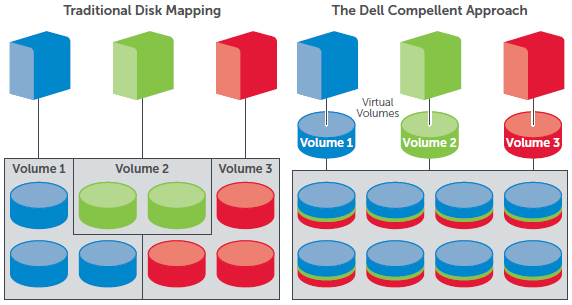
Make all physical disk space available to all volumes from a single shared storage pool.
Storage Center allows the creation of volumes without the need to pre-allocate disk space. And virtualization spreads read/write operations across all of the disk drives rather than limiting availability to a single drive or group of drives dedicated to a volume. Which means you can create volumes from a common pool of storage space without the typical restrictions of RAID grouping or space pre-allocation.
Plus, any volume can simultaneously utilize all of the disk drives in the shared storage pool for improved data access rates. And expired snapshots are automatically coalesced back into the free pool of storage, helping ensure that all available space will always be at your fingertips-automatically.
Maximum utilization, user-defined thresholds
With Dynamic Capacity, you can allocate significantly more capacity than the physical disk you have available, enabling maximum utilization of storage resources. Capacity does not have to be fixed on a per-volume basis, volumes can easily be expanded over time, and volumes can be set to any size within the limits of the operating system.
A flexible pool of storage allows you to create more volumes for different applications and enables more servers to share a single storage system. And automated alerts notify you when remaining free space nears customizable thresholds.
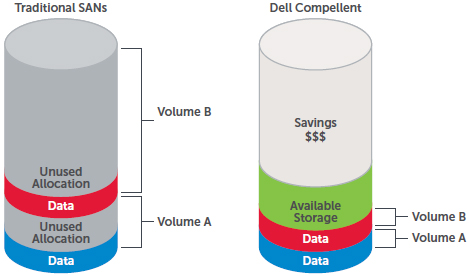
Eliminate allocated but unused capacity.
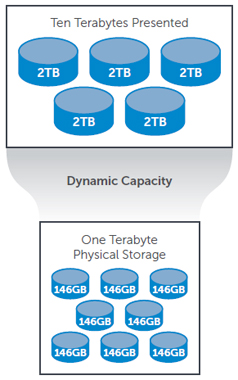 Consume physical space only when data is written
Consume physical space only when data is written
Dynamic Capacity only consumes physical capacity when data is written by the application. This creates smaller, more efficient volumes, increasing the performance of volume-based operations.
Dynamic Capacity allocates on write, so there is less data to write overall-improving the performance of repetitive disk operations. And because Dynamic Capacity volumes only contain actual data, you can accelerate rebuild, copy, replication and backup operations while reducing the amount of bandwidth required.
Automate capacity planning to increase availability
Dell Compellent's intuitive user interface automates routine administrative tasks such as LUN mapping and volume creation, saving valuable administrative time. With Dynamic Capacity, you can create volumes in minutes, easily resize volumes online, add disks, change RAID levels and expand volumes on the fly without disrupting data availability. Automated monitoring of configurable thresholds eliminates the need for time-consuming manual tracking of volume utilization and simplifies capacity planning. And you can save time as application needs grow because volumes don't need constant monitoring and resizing.
Transform legacy volumes into thin provisioned volumes
With Dell Compellent Thin Write and Thin Import technologies, you can accelerate data transfer, minimize downtime and substantially decrease required capacity when migrating from legacy Fibre Channel-based storage systems.
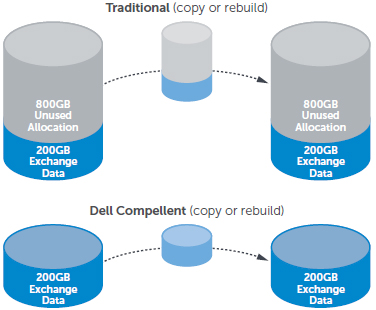
Volumes only contain real data, accelerating performance across a wide range of activities.
Thin Import provides a simple way to migrate data from an existing storage system, automatically converting wasted capacity into thin provisioned volumes. Applications are available to users right away-users do not have to wait until the entire volume is migrated. The Application Optimizer feature tunes storage performance depending on the application being used. By using Thin Import in combination with Application Optimizer, new volumes can be created at the preferred page size.
Thin Write technology transforms existing volumes on the legacy system into thinly provisioned volumes on the Dell Compellent SAN, analyzing the string of data migrating from the legacy system to identify and eliminate true white space-allocated storage space for which no data is actually written.
Improve utilization in Windows environments
Available with Enterprise Manager, Free Space Recovery operates with the Windows file system to identify and reclaim space that is no longer in use.
In other SANs, after Windows files are deleted from a thin provisioned volume, the operating system will continue to report that the space is unavailable. Free Space Recovery automatically reclaims this space over time. The intuitive interface allows for schedule-based recovery or an immediate recovery, and automated management reduces administrative resources and includes notifications upon completion.
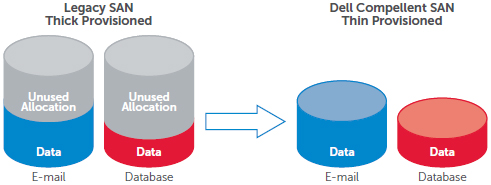
Transform legacy storage data into thin provisioned volumes.
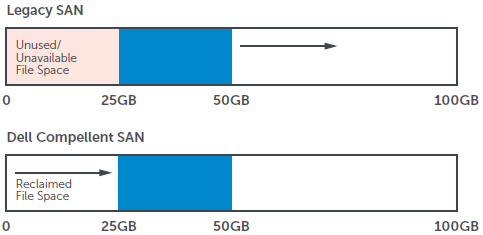
Reclaim available space in Windows environments.
Technical Specifications:
| Dynamic Capacity specifications | |
|---|---|
| Architecture | |
| Allocate on write technology | Yes |
| Pre-allocation required | No |
| Define volumes larger than physical storage | Yes |
| Single pool of storage for all volumes | Yes |
| Automated page-based allocation | Yes |
| Allocation page size | 512KB, 2MB, or 4MB |
| Optimized allocation using Fluid Data architecture | Yes |
| Dynamic RAID level conversion | Yes |
| Performance | |
| Disk operations on written data only (including copy, replication and rebuilds) | Yes |
| Volume creation time | Instantaneous |
| Volume recovery time from Replays | Less than 5 seconds |
| Management | |
| Unified user interface | Yes |
| Continual storage usage monitoring | Yes |
| User-defined thresholds for capacity utilization | Yes |
| Threshold warning notification methods | E-mail, pager, alerts, PhoneHome |
| Storage added online without disruption | Yes |
| Server Environment | |
| Server agent required | No |
| Server operating system support* | Microsoft Windows, Sun Solaris, HP-UX, Linux, IBM AIX, Novell NetWare, Apple, Tru64, VMware |
*See the Dell Compellent Compatibility Matrix for latest supported operating systems

